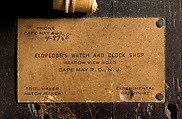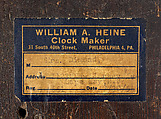Tall case clock
Movement - Peter Stretch American
Movement - Emanuel Rouse
In the 1500s, scientific advances and interest in astronomy led to the more precise measurement of time and the rapid growth of the clockmaking industry in the 1600s. Increasingly, consumers sought out time-telling devices, navigational instruments, and surveying equipment. The Stretch clock illustrates the migration of new technologies into the North American colonies and the adaptation of the more accurate mechanical engineering, like a seconds-beating pendulum and anchor recoil escapement. Clocks were made not only to keep time but to entertain and impress. The towering mahogany case with ornamental carving would have been highly desirable by period standards.
Due to rights restrictions, this image cannot be enlarged, viewed at full screen, or downloaded.
This artwork is meant to be viewed from right to left. Scroll left to view more.









